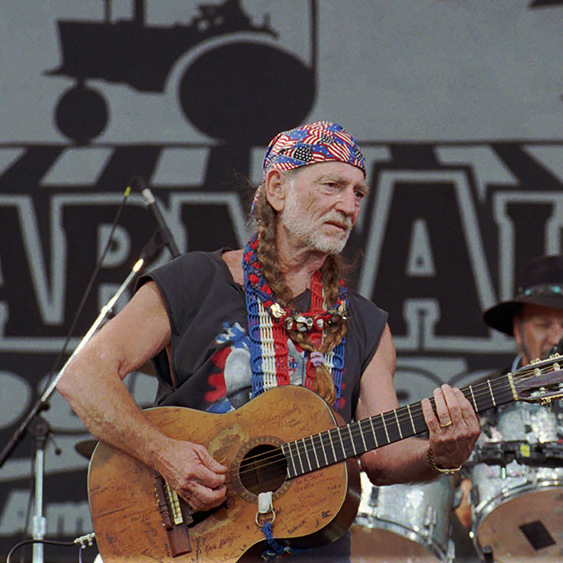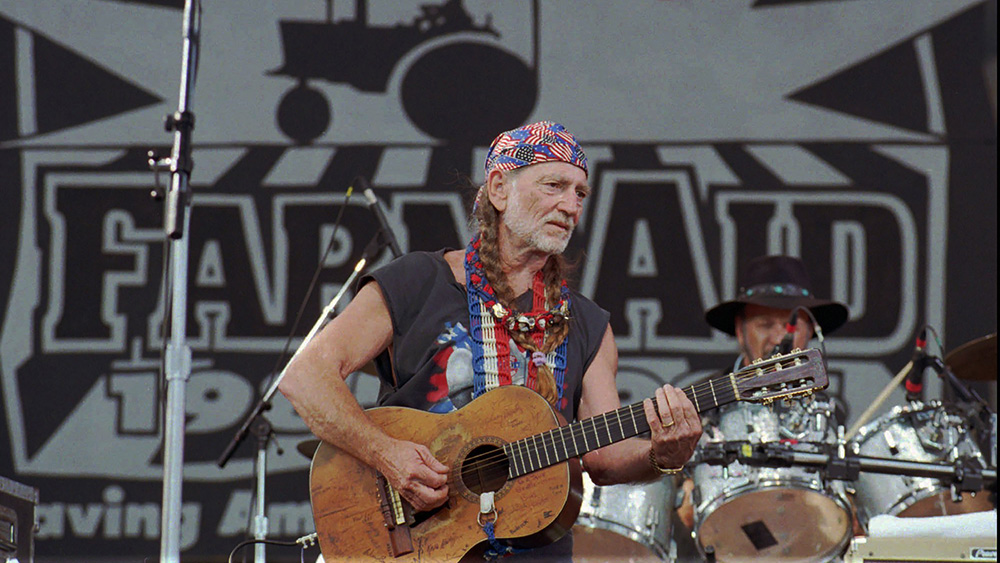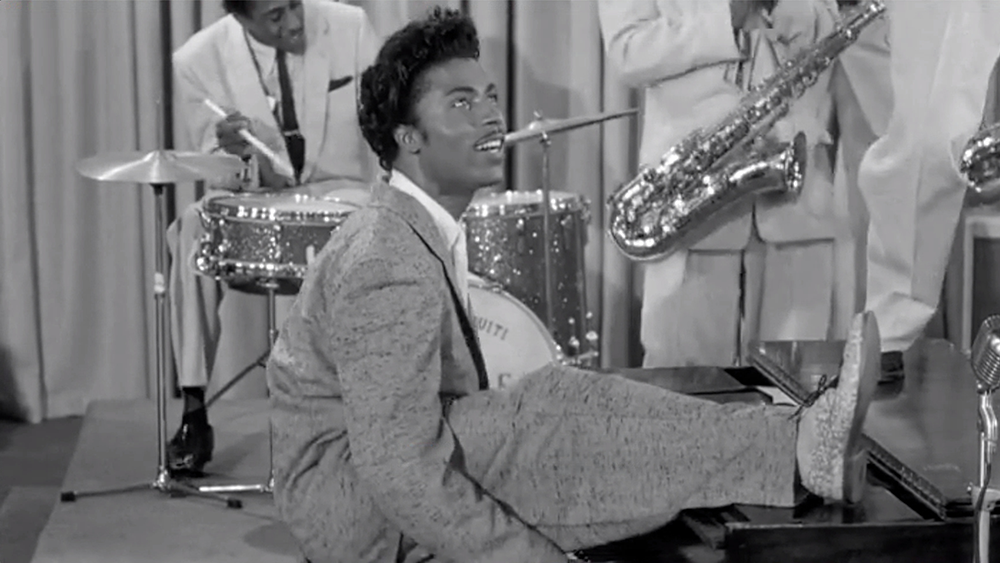
March 29, 2023
Sundance/Slamdance 2023: Music

Still from Willie Nelson & Family
Music took center stage, first with musicians we know. Willie Nelson & Family is a five-part TV series that lets us live up close with the nearly 90-year old musician behind such hits as “Crazy” and “On the Road Again” but also to see his connection to film. There is his early wish to make his 1975 concept album The Redheaded Stranger into a movie for which he built sets on his property called Luck Ranch (Roseann Cash says the concept album is like film citing its illustrations that resemble a storyboard). That was after his childhood desire to emulate singing cowboys like Roy Rogers, Hopalong Cassidy and Gene Autry. Nelson began acting in films with Electric Horseman (1979) followed by Honeysuckle Rose (1980) — for which he wrote the song “On the Road Again”, Barbarosa (1982), and then he did make The Redheaded Stranger (1986).

Still from Little Richard: I am Everything
Little Richard: I am Everything said of himself “I’m the emancipator. I’m the architect. I’m the one that started it all.” Preacher’s son Richard Wayne Penniman AKA Little Richard, the dynamic showman “created the template for the rock and roll icon” according to music producer Nile Rodgers; performer and fashion icon Billy Porter says “Sorry, y’all, it wasn’t Elvis.” As well as being a model for many musicians singing and dancing including Mick Jagger, James Brown, David Bowie, and even Paul McCartney, Little Richard took his inspiration from flamboyant musicians on the Chitlin’ Circuit, Sister Rosetta Tharpe (gay and very bawdy), Billy Wright (green suits, green and gold shoes, pompadour, mascara, pancake makeup and pencil mustache — filmmaker John Waters’s mustache is a tribute to Little Richard’s version), and Esquerita, who played piano standing up. Whereas Fats Domino was the acceptable Black musician, Little Richard was more dangerous, singing about explicit, graphic sex. He was such a dynamic performer, nobody dared follow him, so he had to close shows.
Little Richard was Georgia-born and gay, as are the Indigo Girls, Amy Ray, and Emily Saliers, the folk rock duo profiled in It’s Only Life After All, the title taken from one of their lyrics. Both have become liberal, community-based activists, advocating for gun rights, Native Americans, Confederate monument tear-downs, pro-choice and anti-death penalty.
Against the backdrop of Washington, D.C., essentially a company town where the industry is government, teenagers get involved in the punk music scene in Punk the Capital. With fathers working at Internal Revenue Service (IRS), State Department, and Equal Employment Opportunity Commission (EEOC), this punk scene was extremely well documented and archived, as well as congenial, cooperative, and racially integrated. If punk is a genre that is rooted in its locale, here they called themselves “HarDCore: with “DC” in the middle and used a D.C. flag — 3 X’s and 3 stripes as a logos. The Dead Kennedys punk rock band from California thought the scene was healthy, warm, supportive, and not pretentious. Many practiced “straight edge” which meant no alcohol or drugs and supported voter turnout, and a Black contingent promoted PMA, positive mental attitude. Perhaps the best known figure to emerge from this scene is Henry Rollins. Alas, the scene did begin to attract angry, White Suprematist violent skinheads.
The musician and animal rights activist Moby combines his passions in Punk Rock Vegan Movie. Despite punk’s reputation for brashness and rebellion, Moby makes an argument that it also stood for vegetarianism, animal rights, climate change and deforestation. To them, it is the true meaning of “counterculture” with punk confronting preconceptions, being confrontational and representing people who felt unrepresented in mainstream media: question authority, but don’t hurt anybody. Moby puckishly plays various roles like that of Satan, and has conversations with his dog, Bagel, voiced by a woman.
A fiction film called Jamojaya is about an Indonesian rap artist whose father is obsessed with the legend of Prince Jamojaya, who was killed by his father’s concubine and turned into a banyan tree. The prince’s brother begged the gods to help find him, so they turned the brother into a bird who lands on the banyon tree but cannot hear his brother calling out to him and flies away. The father divided the name and called one son James, the rap artist, and the other Jaya. Jaya was killed in a plane crash, and the father both remembers his deceased son and tries to take care of his rap artist son, who is being Westernized by his label. Culture clashes ensue. The recording is being made in palatial surroundings in Hawaii.
The Mad Writer is the name of a 2012 album by hip hop music producer L’Orange (Austin Hart) when he was based in Nashville. He has a benign tumor in his ear that needs surgery, a critical issue for a musician, whose output is altered by his ailment.
In Honeycomb, a band that has been together for 15 years is on the road with dwindling popularity. Because of a posted video, fans think the lead singer has committed suicide, and the band suddenly trends upwards. Now what do they do? (Audience Award for Episodes, Slamdance)
A middle aged guy who has been making music videos for local bands for decades invented a thriving local music career when he own ambitions to be a rock star flamed out in Space Happy: Phil Thomas Katt and the Uncharted Zone. The Uncharted Zone or UZ is a video news service, the MTV of the Gulf Coast based on the Florida panhandle. The Future House, one of the 100 “portable” ski chalets that looks like a flying saucer, designed by Finnish architect Matti Suuronen in 1968, is featured in his videos as one landed in Pensacola.
In Okay: The ASD Band Film, musicians with Autism Spectrum Disorder (ASD) find solace in music as they prepare for a performance at The Opera House in Toronto.
Music competitions were represented by Pianoforte, the most prestigious piano competition in the world, held in Warsaw since 1927, and Going Varsity in Mariachi, a high school competition in Texas.
Tuba Thieves is ostensibly about the mysterious burglaries of tubas from Los Angeles high schools, but in fact is about deafness, sound, music and performance. What happens when a sound is removed? The filmmaker weaves in such disparate elements as John Cage’s “4′33″ where a pianist sits at the piano in silence for four minutes and 33 seconds and Prince’s concert at Gallaudet University for the Deaf in Washington, D.C. on his 1984 Purple Rain tour.
A fairly ridiculous French music duo who spontaneously call themselves Gwendoline cycle past a Modernist concrete water tower on their way to a gig at a farm. When they perform at a bar, people run out. An older man takes them on as a cause and arranges for them to perform at an old age home where they finally find their perfect audience, depressed seniors. “One hour before the end of the world I still couldn’t decide between Virgin & T-Mobile” is a typical lyric (Grand Jury Awards -Shorts Honorable Mention, Slamdance).
Another absurd tale is Write a Song About Heartache, where a country singer who thinks his songs are surreal (they’re about socks in a drawer, for example) is encouraged to write about loss for a quintessential country western tune. Turns out his muse is an animated green creature who lives in his drawer, who when he is hurt when the songwriter takes out his frustration — run over by a car, put in boiling water, hit by a baseball bat — comes up with a suitable sad song that’s a hit.
The Calling: A Musical VR Experience was in the Digital Game Experience (DIG) section at Slamdance. This immersive musical experience transports you back to a blues cafe on Beale Street in Memphis during the 1968 Sanitation workers strike where MLK was killed at the Lorraine Motel. Triggered by two workers who were killed by malfunctioning trucks, the strike of 1300 workers was tear gassed and billy clubbed by police. In the club, users witness some of the historical scenes, prompted by photos positioned around the club. “This is a story about the audacity of hope, the challenges we overcome, and the choices we can make along the way.”
All Sundance and Slamdance 2023 Category Reviews
The Built Environment
Visual Arts
Media Arts
Art + Life
Performing Arts
Literary Arts
Music
Films Mentioned
Willie Nelson & Family. Directors Thom Zimny and Oren Moverman. Sundance
Little Richard: I am Everything. Director Lisa Cortés. Sundance
It’s Only Life After All. Direcctor Alexandria Bombach. Sundance
Punk the Capital. Directors James June Schneider, Paul Bishop and Sam Lavine. Slamdance
The Mad Writer. Director Zach Kashkett. Slamdance
Honeycomb. Direcctor Sam Roden. Slamdance
Space Happy: Phil Thomas Katt and the Uncharted Zone. Director Louis Crisitello. Slamdance
Okay: The ASD Band Film. Director Mark Bone. Slamdance
Pianoforte. Director Jakub Piatek. Sundance
Going Varsity in Mariachi. Directors Alejandra Vasquez and Sam Osborn. Sundance
Tuba Thieves. Director Alison O’Daniel. Sundance
Gwendoline. Director Joaquin Bayle. Slamdance
Write a Song About Heartache. Director Jonny Look. Slamdance
The Calling: A Musical VR Experience. Director Alani iLongwe. Slamdance
Observed
View all
Observed
By Susan Morris
Related Posts

Arts + Culture
Nila Rezaei|Essays
“Dear mother, I made us a seat”: a Mother’s Day tribute to the women of Iran

The Observatory
Ellen McGirt|Books
Parable of the Redesigner

Arts + Culture
Jessica Helfand|Essays
Véronique Vienne : A Remembrance

Design As
Lee Moreau|Audio
Announcing: Design As Season Two
Recent Posts
Love Letter to a Garden and 20 years of Design Matters with Debbie Millman ‘The conscience of this country’: How filmmakers are documenting resistance in the age of censorship Redesigning the Spice Trade: Talking Turmeric and Tariffs with Diaspora Co.’s Sana Javeri Kadri “Dear mother, I made us a seat”: a Mother’s Day tribute to the women of IranRelated Posts

Arts + Culture
Nila Rezaei|Essays
“Dear mother, I made us a seat”: a Mother’s Day tribute to the women of Iran

The Observatory
Ellen McGirt|Books
Parable of the Redesigner

Arts + Culture
Jessica Helfand|Essays
Véronique Vienne : A Remembrance

Design As
Lee Moreau|Audio

 Susan Morris works across media — film, television, radio, exhibitions, public programs, print, digital media — specializing in the arts and culture with an emphasis on architecture & design as a producer, director, editor, curator and writer. She has worked at Publications: Louise Blouin Media (Editor-in-Chief, Modern Painters), Architect’s Newspaper, Art Newspaper, Artbyte, Documentary, Dwell, Eye, House & Garden, and Design Observer; Foundations: Ford Foundation, NEA, Rockefeller Foundation; Media Production: WNYC/PRI (founding Executive Producer Studio 360), BBC UK, Bravo, IFC, NY Times Television, WNET/Thirteen; Museums & Institutions: Cooper-Hewitt National Design Museum, J. Paul Getty Trust, International House, Metropolitan Museum of Art, MoMA.
Susan Morris works across media — film, television, radio, exhibitions, public programs, print, digital media — specializing in the arts and culture with an emphasis on architecture & design as a producer, director, editor, curator and writer. She has worked at Publications: Louise Blouin Media (Editor-in-Chief, Modern Painters), Architect’s Newspaper, Art Newspaper, Artbyte, Documentary, Dwell, Eye, House & Garden, and Design Observer; Foundations: Ford Foundation, NEA, Rockefeller Foundation; Media Production: WNYC/PRI (founding Executive Producer Studio 360), BBC UK, Bravo, IFC, NY Times Television, WNET/Thirteen; Museums & Institutions: Cooper-Hewitt National Design Museum, J. Paul Getty Trust, International House, Metropolitan Museum of Art, MoMA.